We consider the cleanliness of Budapest's roads and public spaces to be a basic requirement but think little about how many people work to achieve this in winter and summer. At first glance, we might think that this is not such an important job but considering that Fővárosi Közterület-fenntartó Zrt. (FKF – 'Budapest Public Space Maintanence Private Limited Company') currently collects, transports and disposes of waste from nearly 850,000 households and nearly 20,000 business organizations in Budapest, as well as cleaning more than 25 million square metres of roads, pavements, public stairs, 73 underpasses, bridges, overpasses and other facilities; the job is huge and extremely complex.
FKF is celebrating its 125th anniversary this year, after its legal predecessor, the Public Cleanliness Office, was established in the summer of 1895, and the systematic cleaning of Budapest began, from road cleaning to waste collection and transportation.
.jpg)
FKF-owned Mercedes Atego in front of Chain Bridge in the 2000s (Source: Laura Umbrai: 120 év 120 képekben – Az FKF Nonprofit Zrt. története a kezdetektől napjainkig)
During the 1800s, the regular removal of waste and the cleaning of roads increasingly occupied the Budapest administration, which was embarking on the path of urbanization. The custom of the time was mostly that the inhabitants either filled nearby pits, empty plots with rubbish or simply carried the rubbish to the banks of the Danube, creating an unbearable stench in the area.
There was no official provision until 1830 as to what residents should do with their waste, but then it became mandatory to take rubbish to designated places and residents were forced to solve the task. Since many could not do this, it was natural that entrepreneurs soon appeared who applied to take their waste. Later, in 1879, it was forbidden to dispose of one's own waste after various decrees appeared more and more regularly in the capital, which sought to promote the cleanliness of the city.
.jpg)
Shovelling snow into the Danube at the end of the 19h century (Source: Laura Umbrai: 120 év 120 képekben – Az FKF Nonprofit Zrt. története a kezdetektől napjainkig)
Soon, it was the responsibility of the districts and sometimes the fire department to keep the public areas clean and to remove snow. In the 1880s and 1890s, an entrepreneur, Lajos Cséry, started transporting rubbish from dumps in the city centre on horse-drawn carriages. He signed a twenty-year contract with Budapest, as a result of which in May 1893 he built a steam-powered industrial railway from the old military training ground next to Üllői Road to the Szentlőrinc plain, to help remove the rubbish.
Accelerated industrialisation completely changed the urban way of life, and this was reflected in rubbish production, so it became important for a centralized institution in the capital to manage regular waste collection. The Public Cleaning Office was established in 1895, which gradually took over the management and performance of public cleaning and waste transportation tasks.
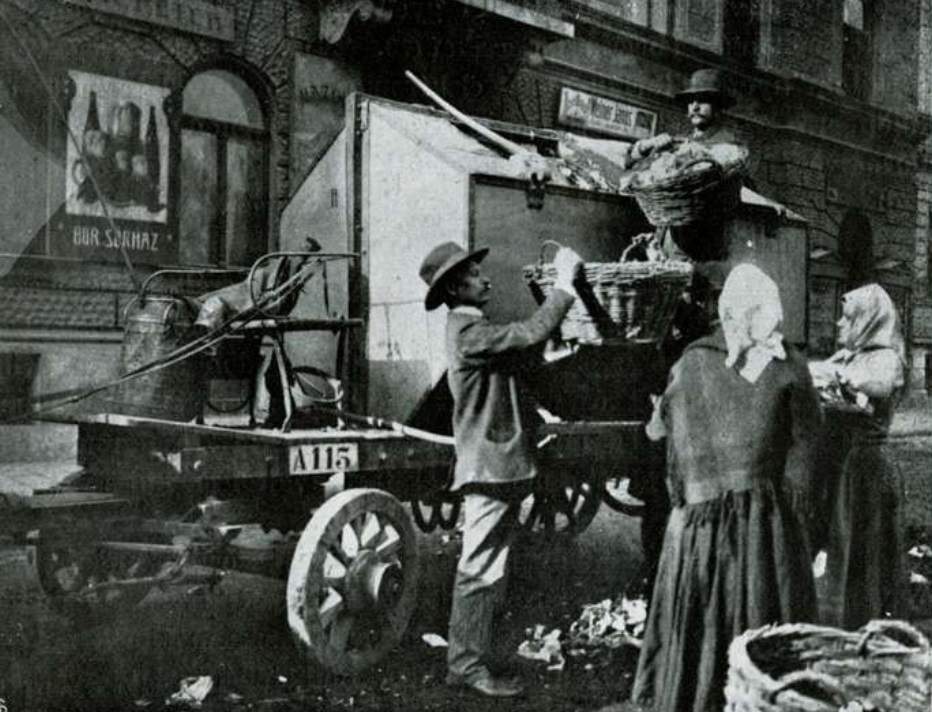 Collection of household rubbish in Budapest in the early 1900s (Photo: FSZEK Budapest Collection)
Collection of household rubbish in Budapest in the early 1900s (Photo: FSZEK Budapest Collection)
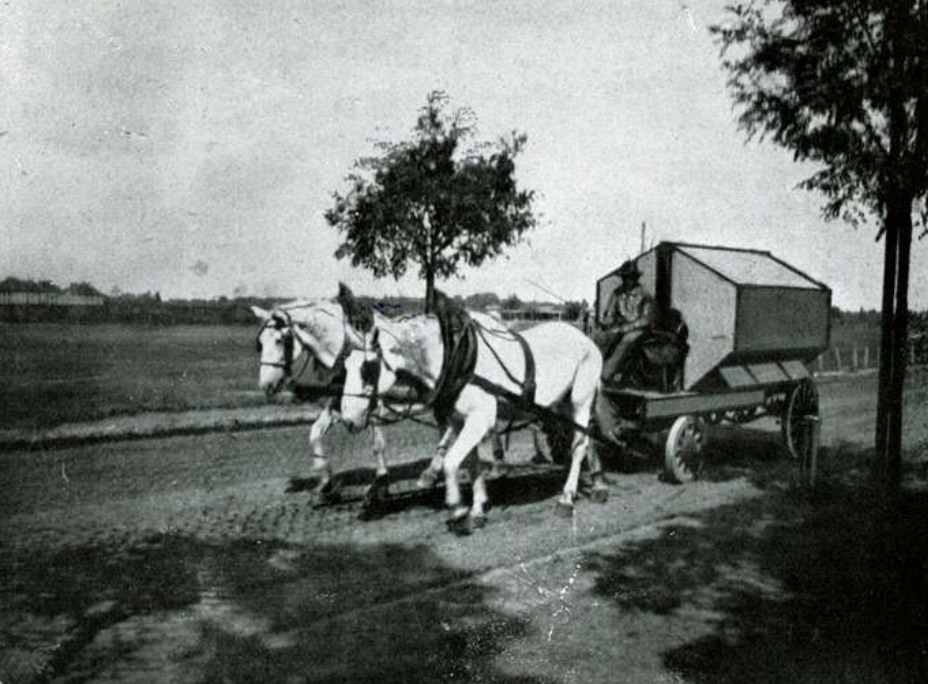
A rubbish truck on its way to the transloading station in Budapest in the early 1900s (Photo: FSZEK Budapest Collection)
.jpg)
Transloading to the garbage train (Photo: Laura Umbrai: 120 év 120 képekben – Az FKF Nonprofit Zrt. története a kezdetektől napjainkig)
Initially, several companies undertook subtasks, such as at the beginning of the 19th century, transporting waste to Ecseri Road was handled by the Budapest Haulers Company, where the collected waste was dumped on rubbish trains. The waste was then transported in two stages. In the first phase, the waste was transported from the city to the Ecseri Road transloading area and from there by train to the Cséry-pit.
The Haulers Company finally merged with the Public Cleaning Office in 1929. Thus the Public Cleaning Office reached its full extent in the 1930s, extending its jurisdiction over the entire city and having control of all branches of public cleaning.
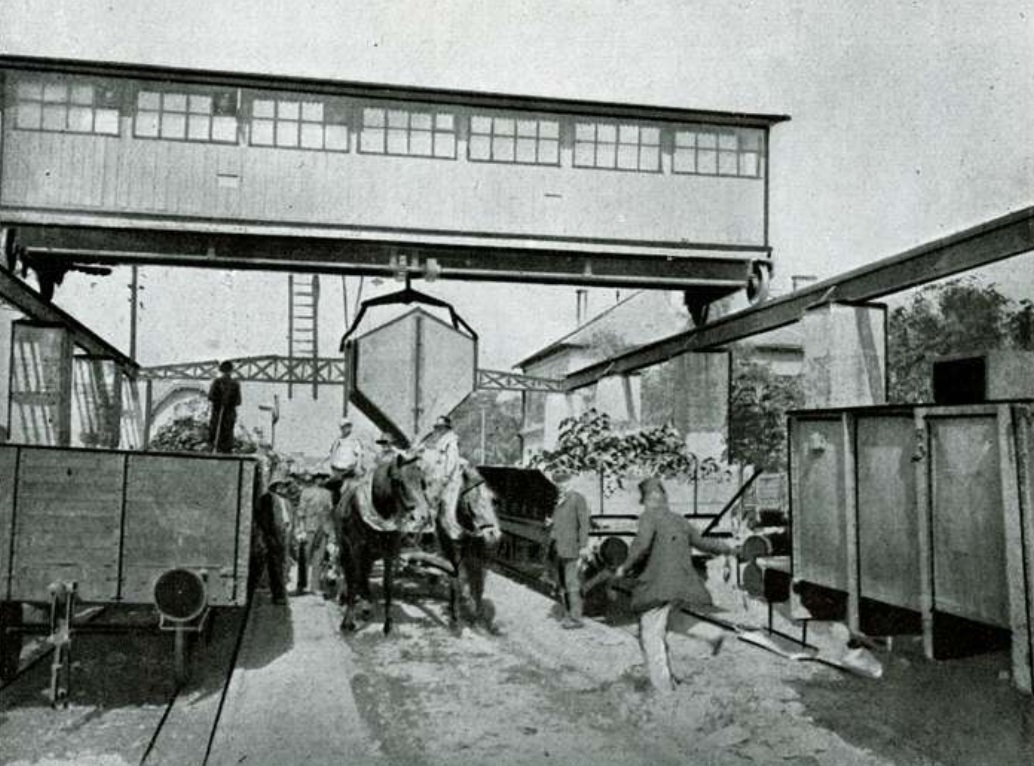
Waste being transferred to a train (Photo: FSZEK Budapest Collection)
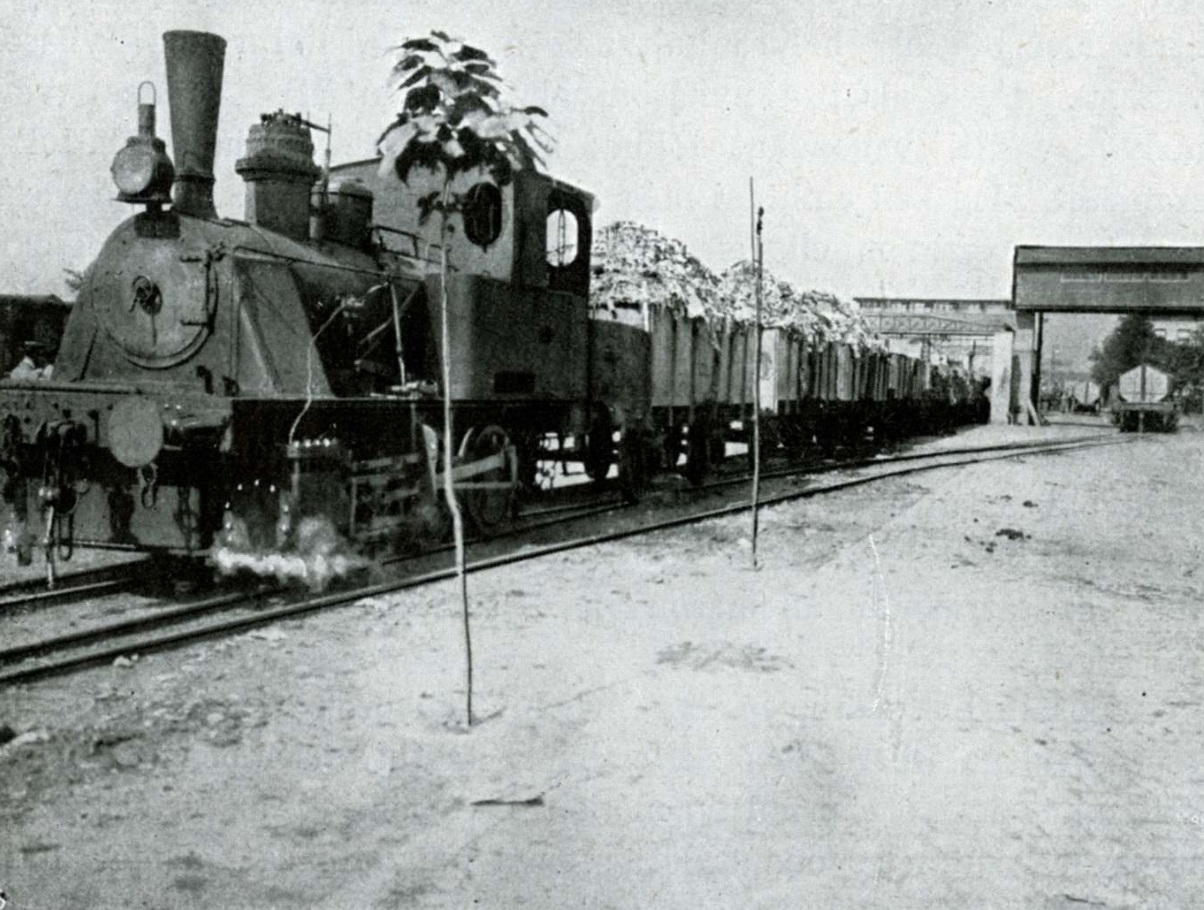
The rubbish train in the early 1910s (Photo: FSZEK Budapest Collection)
Cleaning of public spaces
The streets of Pest and Buda were already being cleaned in the early 1820s. This task was initially performed by prisoners and was directed by the district police stations. Later, private sweepers took over street sweeping, and from 1879 it became the responsibility of the districts to solve the cleaning until the establishment of the Public Cleaning Office in 1895. For a long time, the cleaning and watering of streets was done by hand, which was first taken over by horse-drawn equipment and then by motor-powered machines.
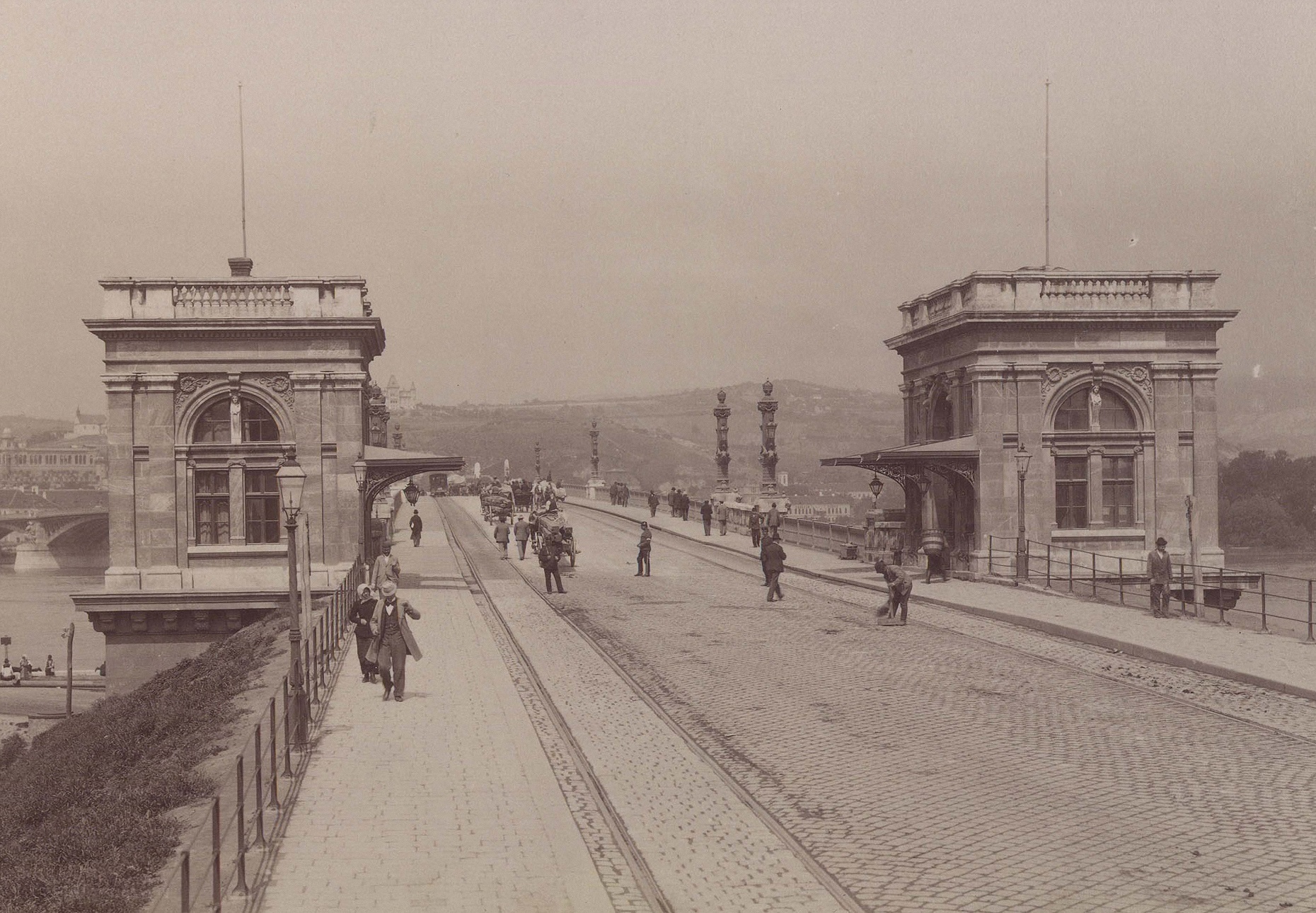
A street sweeper at the Pest end of the Margaret Bridge. Photograph by György Klösz, between 1890-1894 (Source: Fortepan / Budapest Archives)
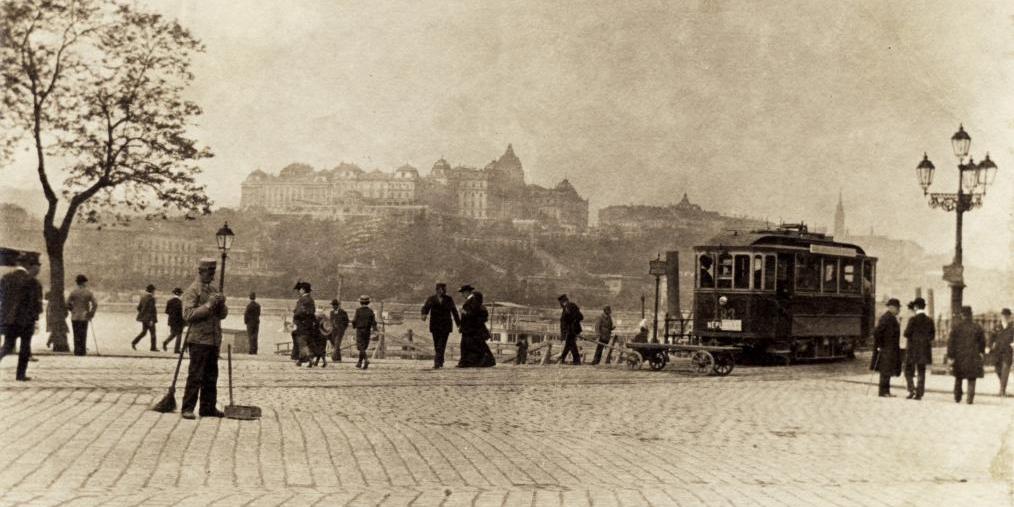
Street sweeper seen on Eskú (today 15 March) Square, opposite the Royal Palace (Source: Fortepan / No.: 115844)
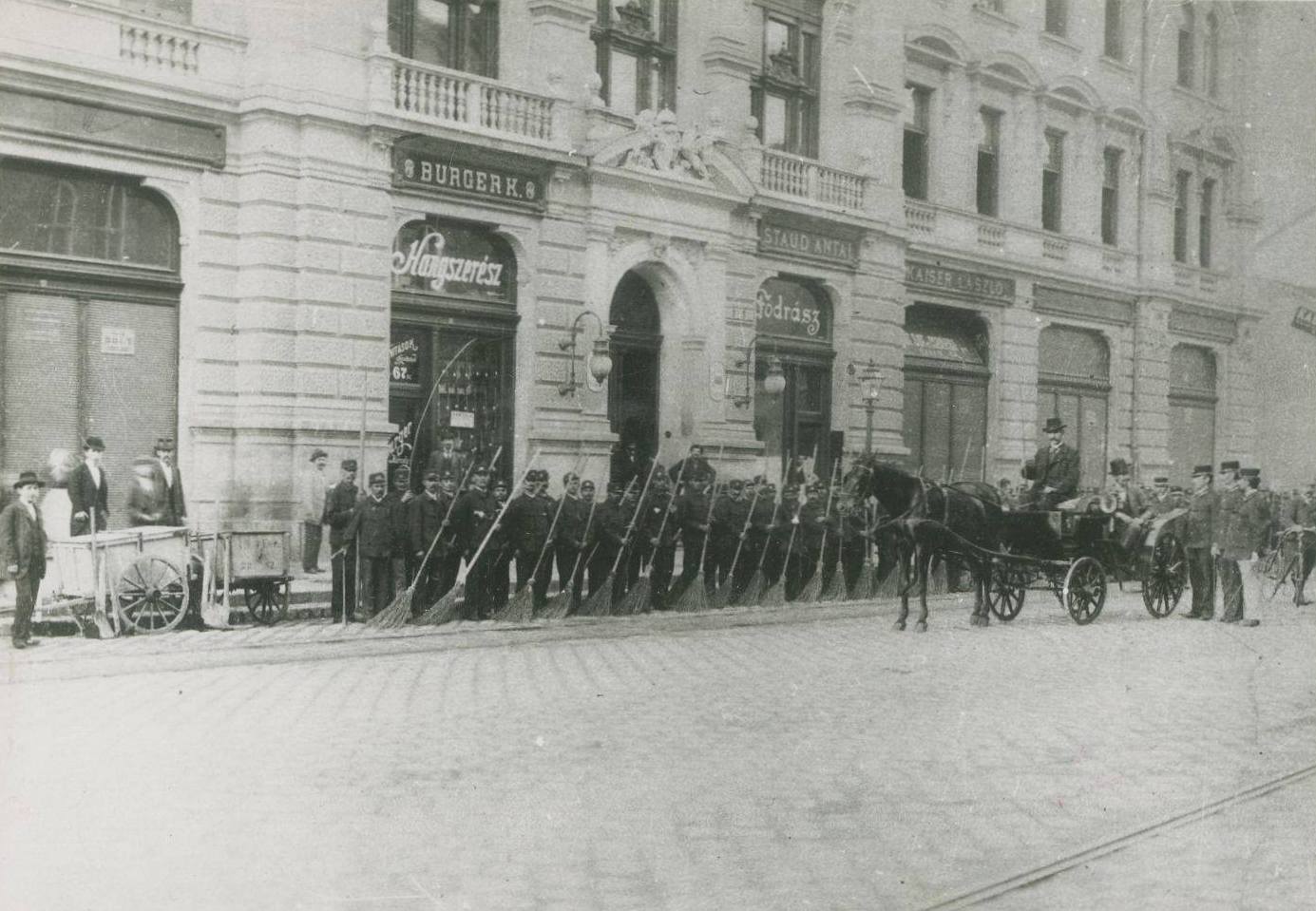
Oktogon visible in the background (Photo: FSZEK Budapest Collection)
Street sweepers did not leave the waste on the side of the street but transported it in wheelbarrows to collection points from where it was transported by the rubbish truck contractor. The first mechanical means of road clearing was the hose cart, first used in the 1870s. 1885 marked a turning point in the mechanization of road cleaning, as it was then that the capital’s first horse-drawn road sweeper and snowplough were put into operation.
.jpg)
Street sweeper on the streets of Budapest at the beginning of the 20th century (Source: Laura Umbrai: 120 év 120 képekben – Az FKF Nonprofit Zrt. története a kezdetektől napjainkig)
.jpg)
The horse-sweepers used since 1885 walked the streets of Budapest for a long time (Source: Laura Umbrai: 1120 év 120 képekben – Az FKF Nonprofit Zrt. története a kezdetektől napjainkig)
.jpg)
Horse-drawn snow plow on Heroes' Square in the early 1900s (Source: Laura Umbrai: 120 év 120 képekben – Az FKF Nonprofit Zrt. története a kezdetektől napjainkig)
The first electric street sweeper appeared in the capital in 1902, and then the first motorized road sprinklers with 9,000-litre water tanks began operating in the 1930s. A few years before the sprinklers, in 1928, the first dust-free garbage trucks appeared, purchased from Keller und Knappich Augsburg (KUKA), and later models were made in Hungary.
The Hungarian word for rubbish bins comes from the acronym of the company's name: K.U.K.A. ~ kuka. The first street bin in Budapest was put out in 1909 on the corner of Museum Boulevard and Kossuth Lajos Street. The first one was made of paper, but later hundreds of metal bins popped up around the city.
.jpg)
The first electric street sweeper (Source: Laura Umbrai: 120 év 120 képekben – Az FKF Nonprofit Zrt. története a kezdetektől napjainkig)
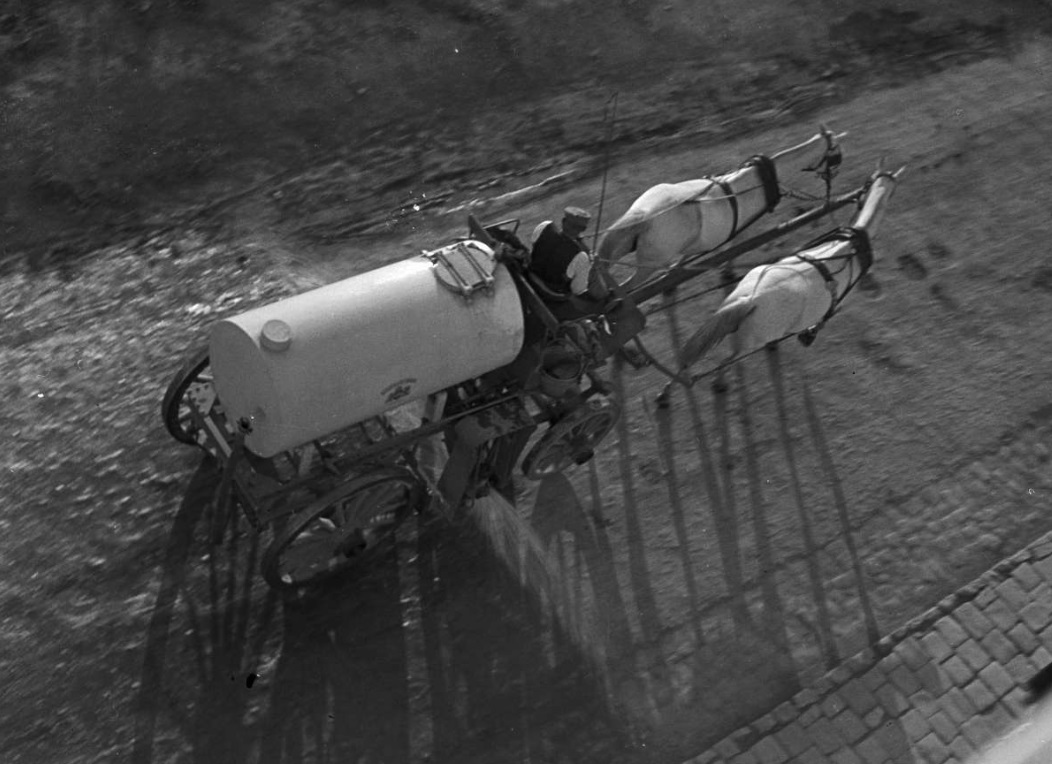
Horse-drawn carriage owned by the capital's sanitation company in 1936 (Photo: FSZEK Budapest Collection)
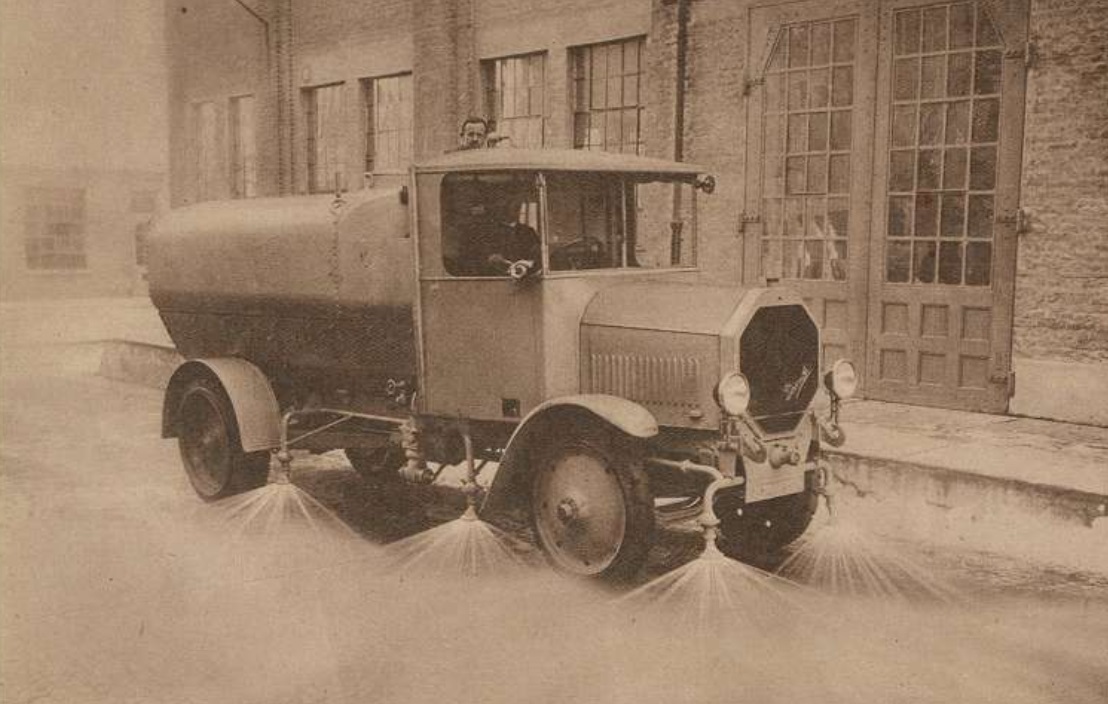 Motorised sprinkler of the Public Cleaning Office in 1928 (Photo: FSZEK Budapest Collection)
Motorised sprinkler of the Public Cleaning Office in 1928 (Photo: FSZEK Budapest Collection)
.jpg)
A double-use vehicle that sprinkled roads in the summer and cleared snow in the winter (Source: Laura Umbrai: 120 év 120 képekben – Az FKF Nonprofit Zrt. története a kezdetektől napjainkig)
.jpg)
Sprinkler, which also cleared snow in winter (Source: Laura Umbrai: 120 év 120 képekben – Az FKF Nonprofit Zrt. története a kezdetektől napjainkig)
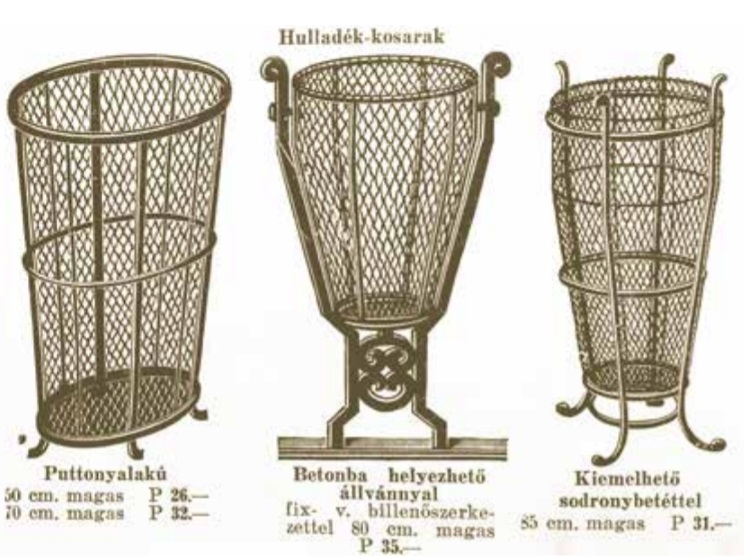
Contemporary graphics of various rubbish bins, which really only spread in the capital in the 1930s (Source: Publication of the Museum of Public Cleanliness)
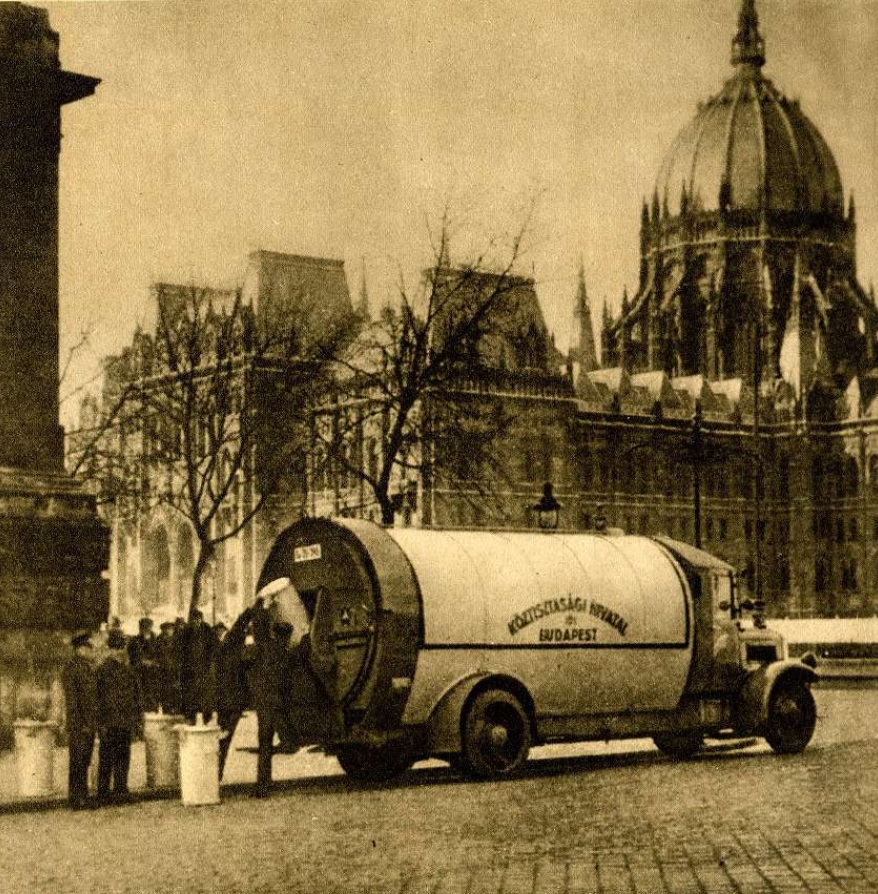
The first dust-free KUKA car carrying waste in the early 1940s (Photo: FSZEK Budapest Collection)
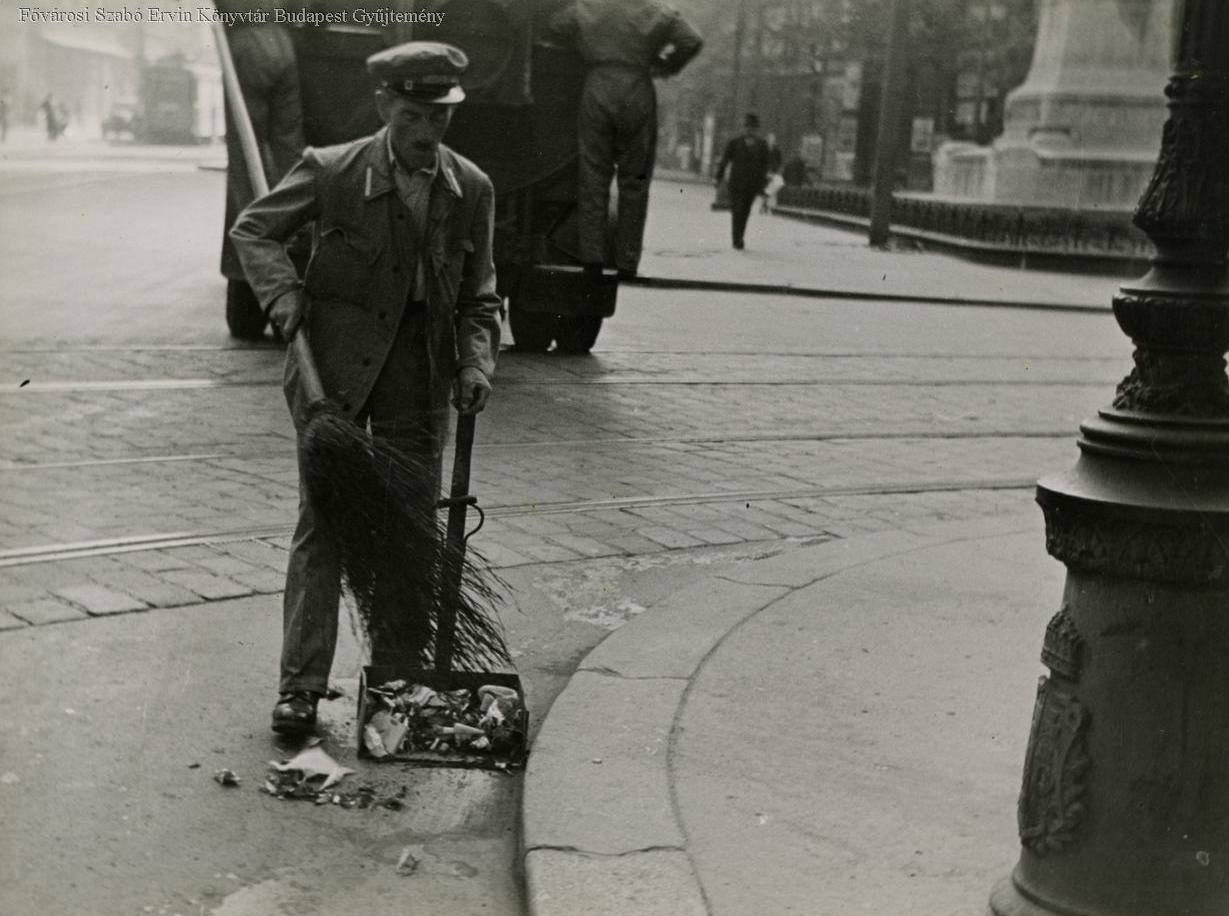
Street sweeper at work in 1943 (Photo: FSZEK Budapest Collection)
After World War II
After the siege of Budapest, the primary task of the Public Cleaning Office was to clean the rubble and solve the challenge despite its machinery and horse-stock being almost completely lost. After Greater Budapest was established in 1950, the size of the city tripled, and this put a huge amount of extra work on the Office. Soon the fleet expanded, and horse-drawn, and garbage rails were eliminated.
In the 1960s and 1970s, several new tasks were added to the Office's activities, such as the production of traffic signs, cleaning bridges, and the removal of larger household rubbish. Although several other companies merged into it over the years, another reorganization took place in 2011, when the entire road maintenance sector was handed over to the Budapest transport company. To this day, FKF Zrt. performs public cleaning tasks, regular communal and waste transportation, and waste management in the capital.
.jpg)
Street sweeper in the 1960s (Source: Laura Umbrai: 120 év 120 képekben – Az FKF Nonprofit Zrt. története a kezdetektől napjainkig)
.jpg) Rubbish truck in the 1960s (Source: Laura Umbrai: 120 év 120 képekben – Az FKF Nonprofit Zrt. története a kezdetektől napjainkig)
Rubbish truck in the 1960s (Source: Laura Umbrai: 120 év 120 képekben – Az FKF Nonprofit Zrt. története a kezdetektől napjainkig)
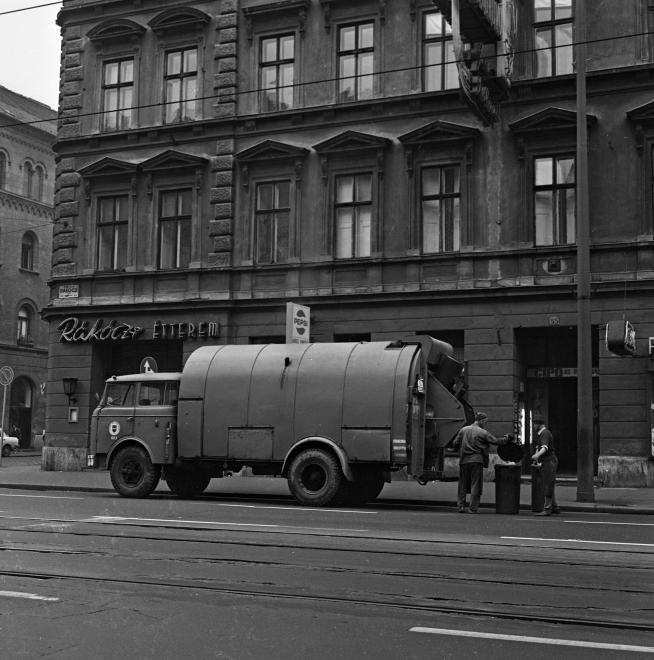
Dustbin van on Rákóczi Road in 1972 (Photo: Fortepan / No.: 15902)
Cleanliness is one of the greatest treasures of any settlement. For the sake of Budapest's beauty, it is important that we all contribute to the work that FKF and its predecessors have done over the past 125 years. Keep the city clean!
Cover photo: Street sweeper seen on Eskü (today 15 March ) Square, opposite the Royal Palace (now Buda Castle). (Photo: Fortepan / ID: 115844)

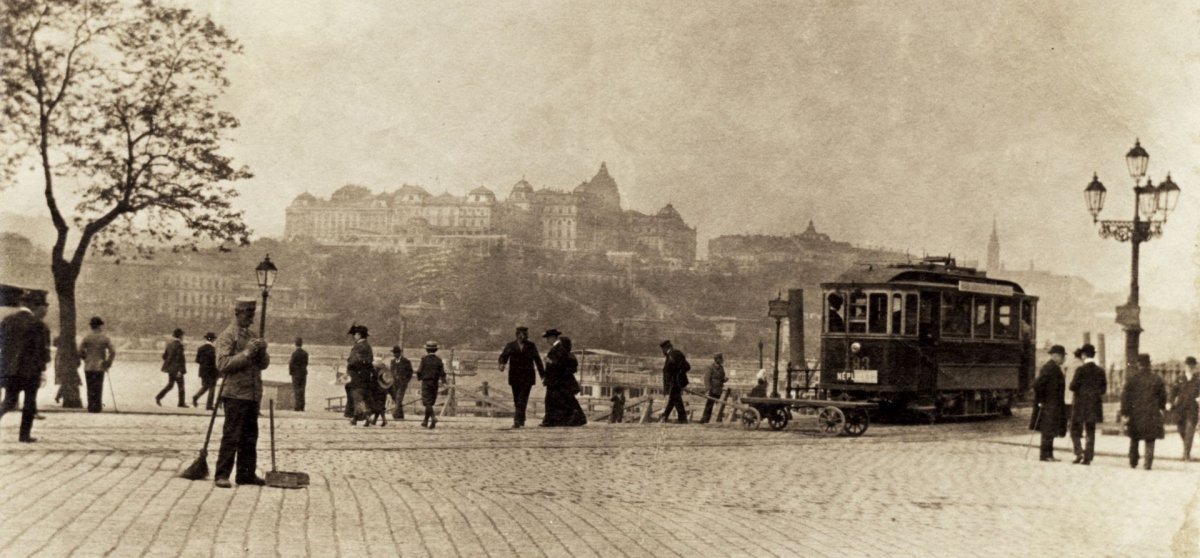



































Hozzászólások
Log in or register to comment!
Login Registration